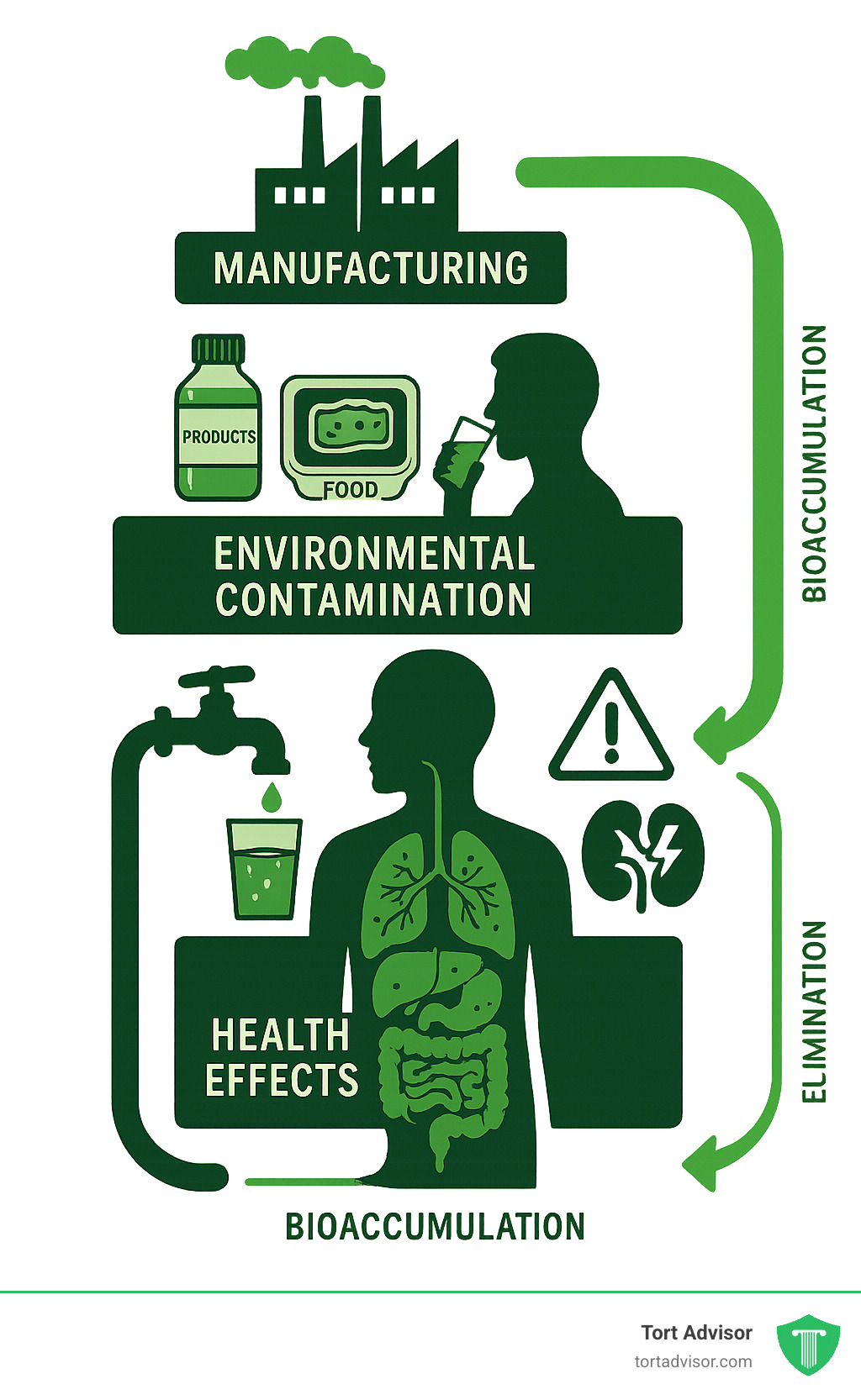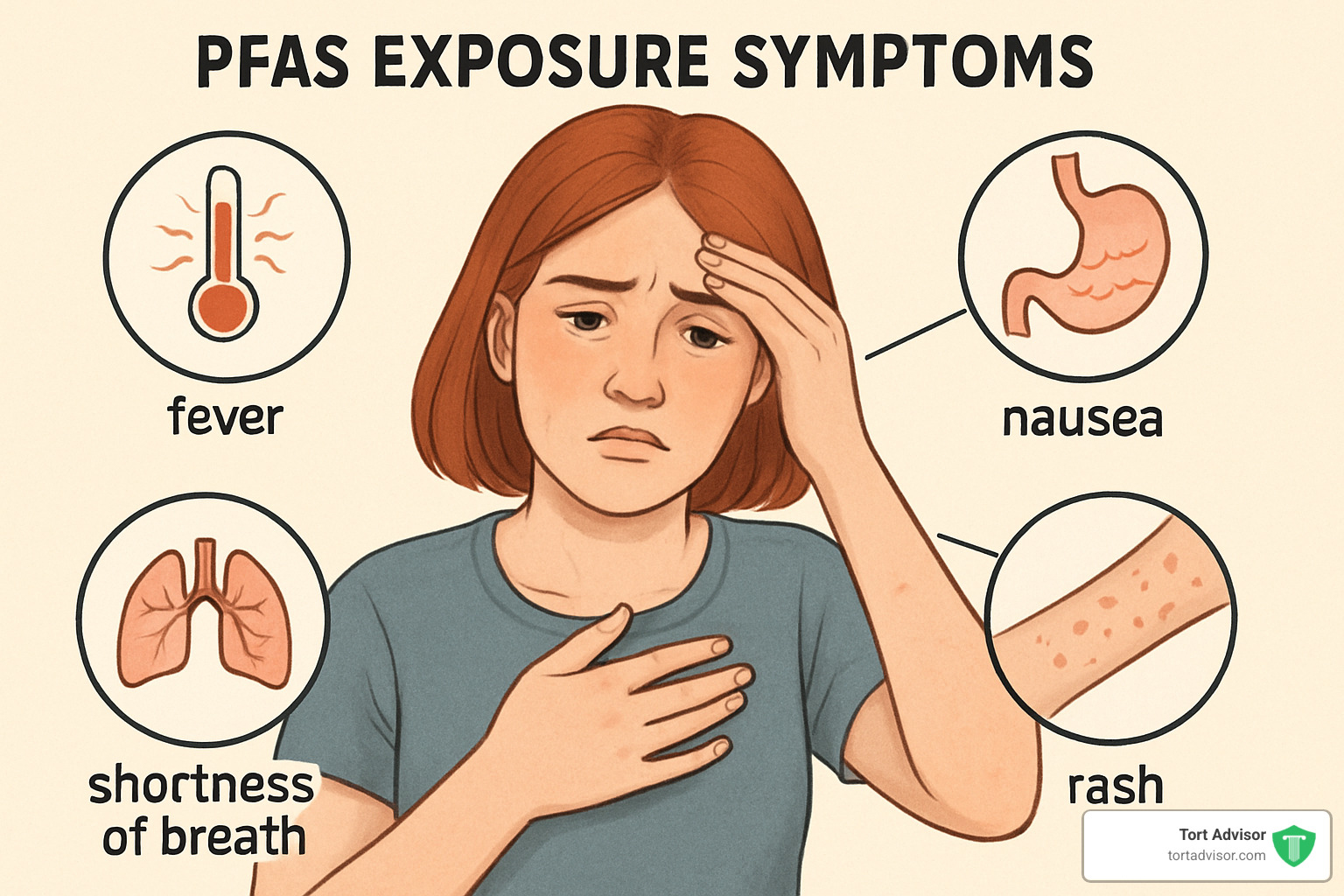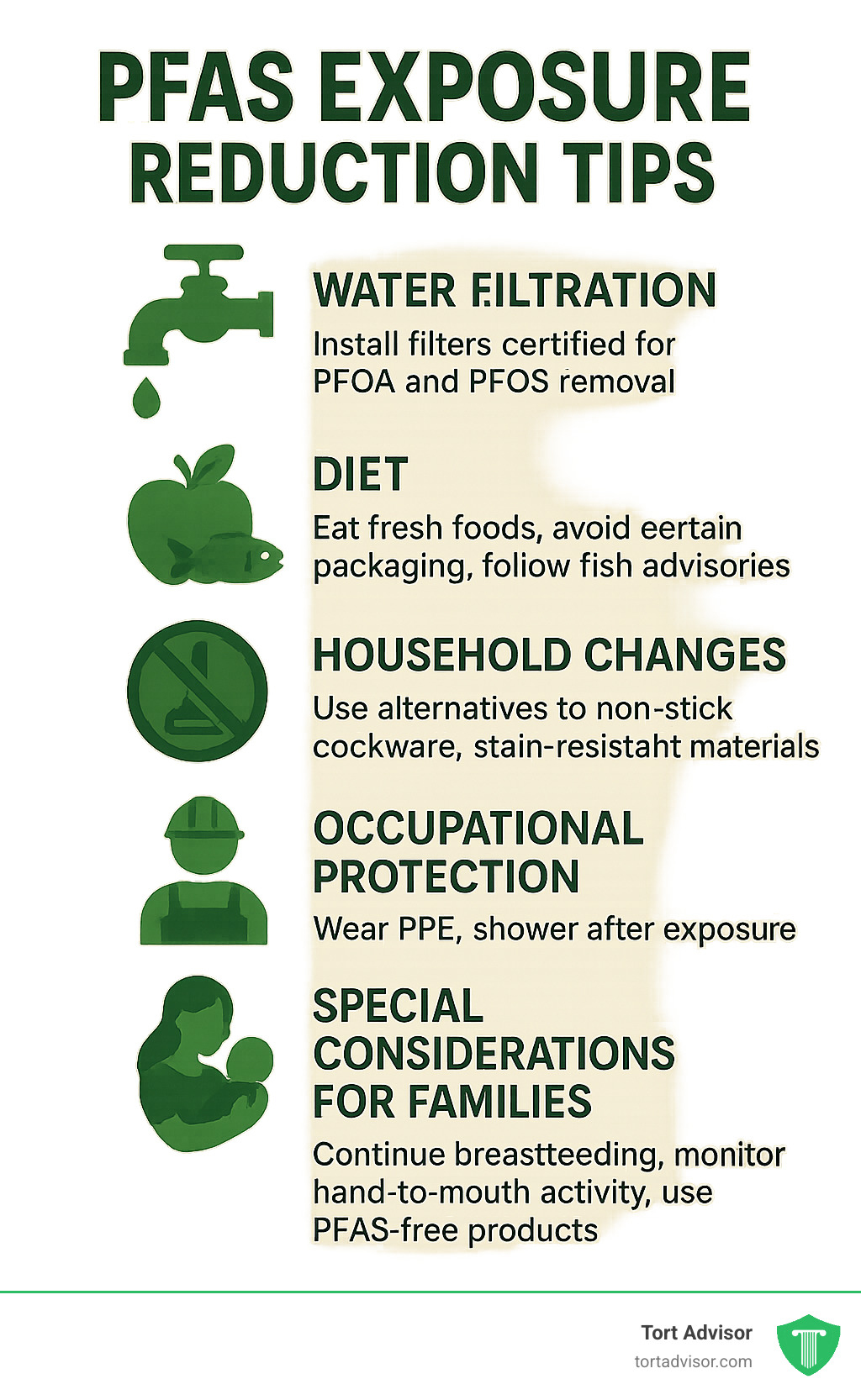


Why PFAS Exposure Symptoms Matter More Than You Think
PFAS exposure symptoms are often subtle and can take years to develop, making them difficult to recognize and connect to their source. Nearly everyone in the United States has been exposed to these “forever chemicals” through contaminated drinking water, food packaging, and everyday products.
Common PFAS exposure symptoms include:
- High cholesterol levels (dyslipidemia)
- Weakened immune response to vaccines
- Thyroid dysfunction and hormone disruption
- Liver enzyme changes and potential damage
- Kidney problems and increased cancer risk
- Reproductive issues including pregnancy complications
- Developmental delays in children
- Increased risk of certain cancers (kidney, testicular)
The challenge with PFAS exposure is that these chemicals accumulate in your body over time. According to the CDC, 97% of Americans have detectable PFAS levels in their blood. What makes this particularly concerning is that PFAS don’t break down easily – they persist in both the environment and your body for years.
The National Academies found sufficient evidence linking PFAS exposure to decreased antibody response, high cholesterol, decreased infant growth, and increased kidney cancer risk. Studies also show limited but concerning evidence for connections to testicular cancer, breast cancer, thyroid disease, and ulcerative colitis.
Understanding these symptoms is crucial because early recognition can lead to better health monitoring and potential legal action if your exposure resulted from contaminated water or occupational hazards.
I’m Mason Arnao, and through my work in technology and data management, I’ve analyzed extensive health databases that track environmental exposures like PFAS exposure symptoms across different populations.

Basic pfas exposure symptoms terms:
– pfas cancer lawsuit
– pfas exposure risks
Quick Facts: What Are PFAS & How Do We Encounter Them?
PFAS stands for per- and polyfluoroalkyl substances – a huge chemical family with thousands of different members. Scientists call them “forever chemicals” because these substances literally don’t break down naturally in the environment or in our bodies.
Your daily encounter with PFAS happens more often than you’d think. The biggest culprit is your drinking water – the EPA found that nearly half of all U.S. tap water contains these chemicals. That morning glass of water could be delivering a daily dose of PFAS right to your system.
But water isn’t the only source. Every time you grab pizza from a grease-resistant box, microwave popcorn, or unwrap fast food, you’re potentially exposed through food packaging. The same properties that keep grease from soaking through also mean PFAS can migrate into your food.
Firefighters and military personnel face some of the highest exposures through AFFF foam (aqueous film-forming foam). This foam is incredibly effective at fighting fuel fires, but it’s also loaded with PFAS chemicals. Veterans and firefighters often show much higher blood levels of these substances.
If you work at manufacturing facilities, airports, or certain military bases, occupational dust exposure becomes a real concern. These workplaces often have liftd PFAS levels that workers can inhale or accidentally ingest throughout their workday.
The scary part about PFAS is bioaccumulation – they build up in your body faster than they can leave. While some PFAS like PFBA clear out in about 3 days, others like PFOA can stick around for over 8 years.
Here’s the reality check: nearly every American has measurable PFAS in their blood. The average PFOS level in U.S. adults sits around 4.25 ng/mL, with 95% of people having levels under 14.6 ng/mL. These numbers represent the widespread nature of our exposure to these pfas exposure symptoms-causing chemicals.
The Scientific research on PFAS basics shows just how pervasive these chemicals have become in our daily lives, making understanding their health impacts more crucial than ever.
Top 12 PFAS Exposure Symptoms to Watch For

PFAS-related health problems often look like everyday issues, so they slip under the radar. Below are the most consistently reported PFAS exposure symptoms. If several apply to you—especially if you live or work near a known contamination site—consider speaking with your doctor.
Most common red flags
- Persistent high cholesterol that doesn’t improve with diet or exercise
- Frequent infections or weak vaccine response
- Thyroid dysfunction (energy swings, unexplained weight change)
- Liftd liver enzymes or unusual fatigue after meals
- Kidney changes (back pain, protein in urine) and higher kidney-cancer risk
- Worsening ulcerative colitis or other inflammatory bowel issues
- Reproductive problems: irregular periods, fertility struggles, pregnancy hypertension
- Developmental delays or low birth weight in children
- Unrelenting chronic fatigue and reduced bone density (teens)
- Greater odds of kidney or testicular cancer
Adults
In grown-ups, metabolic issues come first. Stubborn LDL levels, new thyroid nodules, or mild but chronic liver discomfort are typical early signs. Immune problems follow—you catch every cold and take longer to bounce back.

Children
Kids absorb more PFAS for their size, so symptoms can be dramatic: persistent asthma, frequent ear infections, slow growth, or attention difficulties. Poor vaccine response is another early clue pediatricians watch for.
Reproductive health
Women may notice cycle irregularity first, then difficulty conceiving or high blood pressure during pregnancy. Men often see decreased sperm quality. PFAS transfer through breast milk, so lowering a mother’s exposure protects infants, too.
PFAS-Linked Diseases: Strength of Evidence
When doctors and researchers study PFAS exposure symptoms, they don’t just look at whether a health problem exists – they carefully examine how strong the scientific evidence is. Think of it like building a case: some evidence is rock-solid, while other evidence points in the right direction but needs more investigation.
The National Academy of Sciences has done the heavy lifting here, reviewing thousands of studies to categorize PFAS health effects. This isn’t just academic exercise – these categories directly impact how your doctor should monitor your health if you’ve been exposed to PFAS.
The strongest evidence – what scientists call “sufficient evidence” – exists for four key health problems. First, decreased antibody response shows up consistently across multiple high-quality studies. This means your vaccines might not work as well as they should. Second, dyslipidemia or high cholesterol appears in study after study, affecting both adults and children. Third, decreased infant and fetal growth shows small but significant reductions in birth weight. Finally, increased kidney cancer risk demonstrates significantly higher odds for people with the highest PFOA exposure levels.
The “limited or suggestive evidence” category includes several serious conditions that researchers are watching closely. Testicular cancer appears in multiple studies but needs more research to nail down the exact relationship. Breast cancer shows emerging evidence that’s promising enough to warrant attention but requires additional confirmation. Thyroid disease has clear associations in studies, though scientists are still working out exactly how PFAS affects thyroid function.
Ulcerative colitis falls into this category too, with studies showing 1.6 times increased odds per unit of log PFOA (95% CI: 1.14-2.24). Pregnancy-induced hypertension also has evidence linking it to exposure above EPA advisory levels, making it particularly concerning for expectant mothers.
| Evidence Level | Health Conditions | What This Means |
|---|---|---|
| Sufficient Evidence | Decreased antibodies, High cholesterol, Decreased infant growth, Kidney cancer | Strong, consistent findings across multiple studies |
| Limited Evidence | Testicular cancer, Breast cancer, Thyroid disease, Ulcerative colitis, Pregnancy hypertension | Promising evidence that needs more research |
| Insufficient Evidence | Many other conditions | Not enough data yet – doesn’t mean effects don’t exist |
“Insufficient evidence” doesn’t mean these other health effects don’t happen – it simply means researchers haven’t collected enough data yet to make definitive statements. PFAS research is relatively new, and scientists are still uncovering connections between exposure and various health problems.
This evidence-based approach helps explain why some PFAS exposure symptoms get more attention than others in medical settings. Your healthcare provider will likely focus monitoring efforts on the conditions with sufficient evidence while staying alert for emerging patterns in areas with limited evidence.
For detailed information about cancer connections, see Scientific research on cancer link and More info about PFAS Exposure Risks.
Testing & Diagnosis: How to Confirm and Interpret Results
If you’re experiencing PFAS exposure symptoms, you might wonder whether testing can provide answers. The reality is both promising and frustrating – while we can measure PFAS in your blood, interpreting what those numbers mean for your health isn’t always straightforward.
PFAS blood testing (also called biomonitoring) measures the current levels of specific PFAS compounds in your bloodstream. Think of it as a snapshot of your body’s PFAS burden at that moment. The test can tell you whether your exposure levels are higher than typical and track changes over time.
However, there are important limitations. Blood tests cannot predict your future health risks or definitively tell you whether your current symptoms are caused by PFAS exposure. They also can’t prescribe a specific treatment plan, since there’s no established medical protocol for “treating” PFAS exposure.
Getting tested isn’t as simple as asking your family doctor. PFAS blood testing isn’t routinely available at all medical facilities, and it’s not part of standard health screenings. VA medical centers don’t currently offer PFAS blood testing, which is particularly concerning given the high exposure rates among veterans and firefighters.
Private laboratories do offer testing, but costs vary widely and insurance coverage is inconsistent. Some people pay out of pocket for peace of mind, while others focus their resources on reducing ongoing exposure instead.
When testing makes sense, it’s usually for people with known high exposure – those who lived near contaminated military bases, worked with AFFF firefighting foam, or have private wells with confirmed PFAS contamination. If you’re planning a pregnancy or experiencing unexplained symptoms consistent with PFAS effects, testing might provide valuable baseline information.
Interpreting your results requires understanding reference points. The NASEM (National Academies of Sciences, Engineering, and Medicine) has established thresholds that suggest when clinical follow-up might be warranted. The ATSDR clinician guide provides healthcare providers with frameworks for understanding what different levels might mean.
German HBM (Human Biomonitoring) values offer additional reference points that some clinicians find helpful. Population percentiles help put individual results in context – knowing whether you’re in the 50th or 95th percentile compared to other Americans can inform decisions about monitoring and exposure reduction.
For many people, testing their water source is more actionable than blood testing. If you rely on private wells, water testing can directly guide decisions about filtration or alternative water sources. The EPA’s new drinking water standards limit six PFAS compounds to 4 parts per trillion.
The lack of routine screening reflects the current state of PFAS science – we know these chemicals cause harm, but the medical community is still developing protocols for monitoring and treatment. This gap is slowly closing as more healthcare providers become educated about PFAS health effects.
For comprehensive information about testing options and interpretation, you can review Scientific research on PFAS blood testing, which provides detailed guidance for both patients and healthcare providers navigating this evolving field.
Reducing Exposure & Protecting Your Health

You can’t erase decades of contamination, but you can sharply cut new intake.
Prioritize water first. Install an NSF/ANSI-certified reverse-osmosis or activated-carbon filter and swap cartridges on schedule. If you’re on a private well, test it annually; remediation is cheaper than treating illness later.
Rethink the kitchen. Trade non-stick pans for stainless steel or cast iron, and limit grease-resistant fast-food wrappers and microwave popcorn. A diet rich in fiber and folate may blunt some metabolic effects seen with PFAS.
Dust and textiles. Vacuum often and wash hands before meals. Skip “stain-resistant” carpets and sofas when you replace household items.
Work smart. Firefighters, airport crews, and chemical-plant staff should use full PPE, then shower and change before heading home.
Family matters. Health agencies still recommend breastfeeding; its benefits beat the small PFAS transfer. Instead, focus on lower-PFAS baby products and follow local fish advisories.

Even simple changes add up. Cleaner water, smarter food choices, and a dust-free home together lower your daily dose and, over time, your body burden.
Frequently Asked Questions about PFAS Exposure Symptoms
Understanding PFAS exposure symptoms becomes even more important when certain groups face dramatically higher risks than the general population.
What groups are at highest risk?
Firefighters top the list due to regular use of AFFF (aqueous film-forming foam). Veterans and military personnel also have liftd exposure, with over 700 U.S. bases potentially contaminated. Pregnant women, infants, and industrial workers who handle PFAS directly face unique vulnerabilities.
Can PFAS exposure cause specific cancers?
The strongest link is to kidney cancer. Testicular cancer has limited but suggestive evidence, while ongoing studies examine possible ties to breast and thyroid cancers. Recent analyses estimate 4,600-6,800 U.S. cancer cases per year could stem from PFAS-tainted drinking water.
Should I ask for a PFAS blood test?
Testing makes sense if you’ve had clear high exposure—living near a contaminated site, using a polluted well, or working with AFFF. Results provide a baseline for future monitoring but can’t predict disease or guide a cure. If you test, plan regular cholesterol and liver checks and focus on cutting further exposure.
Conclusion
Living with the uncertainty of PFAS exposure symptoms can feel overwhelming, especially when these “forever chemicals” seem to be everywhere. But here’s what I want you to remember: awareness is your first line of defense, and you’re not powerless in this situation.
The reality is sobering – nearly all Americans carry detectable PFAS in their blood, and these symptoms often creep up so gradually that we dismiss them as normal aging or stress. But recognizing the warning signs early can genuinely change your health trajectory and open doors to both medical care and legal remedies.
What we know for certain is that PFAS exposure has strong connections to cholesterol problems, weakened immune systems, kidney cancer, and developmental issues in children. The evidence keeps growing stronger, not weaker, which means the medical community is taking these concerns more seriously than ever before.
If you’re dealing with unexplained health issues – persistent high cholesterol despite healthy eating, frequent infections, or reproductive problems – don’t let doctors brush off your concerns. Blood testing has its limitations, but it can provide valuable information, especially if you know you’ve had high exposure from contaminated water or workplace hazards.
The good news is that you can take meaningful action to reduce your family’s exposure. Simple changes like installing the right water filter, switching to stainless steel cookware, and choosing fresh foods over packaged options can significantly lower your PFAS burden over time.
For those facing serious health consequences from PFAS exposure, particularly from contaminated drinking water or occupational exposure, legal options are available and actively being pursued across the country. Recent settlements have reached hundreds of millions of dollars for affected communities, and the landscape continues to evolve in favor of those harmed by these chemicals.
At Tort Advisor, we understand how frustrating it can be to steer both health concerns and potential legal remedies simultaneously. That’s why we connect clients with experienced attorneys who specialize in PFAS litigation and have successfully handled complex environmental exposure cases. Our network includes lawyers who understand the unique challenges of proving PFAS-related health damages and know how to build strong cases.
Consider reaching out for legal consultation if you’ve been diagnosed with kidney or testicular cancer after known PFAS exposure, live in a community with widespread contamination affecting property values, experienced occupational exposure leading to health problems, or consumed contaminated drinking water from industrial or military sources.
The key is acting sooner rather than later. Early consultation helps preserve your rights and ensures proper documentation of both your exposure and health effects – critical elements in any potential legal action.
For detailed information about potential legal remedies and compensation options, visit More info about PFAS Cancer Lawsuit.
Recognizing PFAS exposure symptoms early isn’t just about your health – it’s about protecting your family’s future and holding responsible parties accountable. You deserve clean water, safe workplaces, and honest information about the products you use every day. When those basic rights are violated, legal remedies exist to help make things right.
Free Confidential Case Evaluation
Complete the short form below to get an immediate FREE case review with an expert in your specific claim. Don't wait, your case could be time sensitive to file a claim.
Related Posts
Did a North Dakota product cause harm? Understand product liability, your rights, and how to take action for defects.
Get justice for clergy abuse. Find an expert Priest abuse lawyer to navigate complex laws and hold institutions accountable.
Diagnosed with meningioma after Depo-Provera? Understand potential Depo-Provera lawsuit settlements, risks, & how to claim compensation.
Uncover the truth about uber sexual assault cases. Learn about the alarming scale, Uber's accountability, and legal options for justice.
Facing wildfire losses? Discover the best wildfire lawsuit attorneys in California to fight for your full recovery and justice.
Exposed to Roundup & diagnosed with NHL? Discover how to sue Monsanto, understand eligibility, & seek compensation. Your guide to justice.






